Spruce up your veterinary hospital to attract new associates or buyers
Small touch-ups and an objective look at your space will go a long way in getting an associate or other potential practice buyer interested.

We recently received a call from the new owner of a hospital we designed more than 25 years ago. And it turns out that five years ago, the soon-to-retire veterinarians invested in a hospital makeover. The small changes they made, while superficial in nature, were critical to communicating that this was a desirable and thriving practice. Today, the former owners are retired and the new owners are happy and busy.
What can you learn from this success story? Here, we'll explore three strategies you can use to tune up your hospital to appeal to the next generation of practitioners-or curious corporate buyers. Whether you have $5,000 or $250,000 to spend, you can give your hospital a much-needed makeover and create your own success story.
1. Fire up your first impression
When was the last time you looked at your practice from an outsider's perspective? Try this exercise: Drive into your entryway, park in the visitors' lot and come in the front door. What is the experience like? Is the building inviting and vibrant, or is it worn-out and dated? First impressions-which can help or hurt you-matter to anyone new to a business. Your hospital is a physical manifestation of who you are and the medicine you practice. Consider these ideas to improve your “front of house”:
> Upgrade your signage. Building signage is often the first things visitors see. A well-designed, professional sign can change the look of an entry drive or the front façade of a building. It's worth hiring a signage company to help you investigate your options for creating a more professional and welcoming first impression.

The exterior signage of Tryon Equine Hospital in Columbus, South Carolina. Photo courtesy of Tim Murphy, Foto Imagery, Ltd.
> Rejuvenate reception. Many older reception areas have barrier-style desks that open to a business office behind. This feels cluttered and unfriendly. By separating the business office from the reception area, cutting down physical barriers, and upgrading finishes and lighting, it's possible to entirely transform the client service experience.
Check out these "before" and "after" photos of one veterinary reception-area remodel.
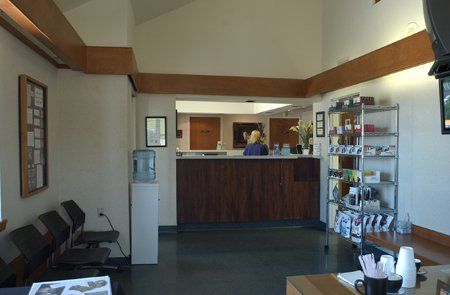
Hulen Hills Animal Hospital's reception area before remodel. Photo courtesy of Dr. Steve Hotchkiss
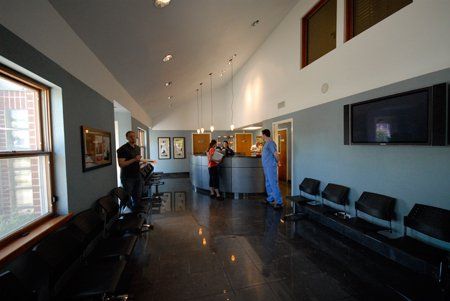
Hulen Hills after their remodel. Photo courtesy of Dr. Steve Hotchkiss.
> Catch up with color. Many hospitals settle on white, because it's clean, bright and professional-and that's what many human hospitals were going for too. These are important considerations, but it's possible to add a little color for a lot of impact.
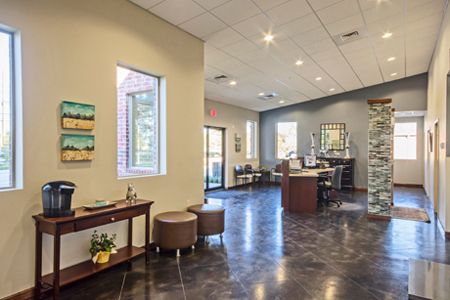
Country Club Veterinary Clinic in Lake Charles, Louisiana, uses a soothing combination of neutrals in their reception area. Photo courtesy of Sal Longo Jr.
2. Make the most of medical and patient areas
Your work spaces get used hard by staff and patients on a daily basis. Finishes wear out, rooms change use, and, sometimes, the hospital's old floor plan just doesn't function as well. What can you do to make improvements?
> Tweak the floor plan. When our architecture firm begin a veterinary hospital makeover, the first thing we look at is the floor plan. Enlist the help of an experienced building professional to develop your top priorities. For example, if the hospital works well but is out of style, you may focus on a superficial renovation. However, if the flow and efficiency needs to be improved, it may be wise to focus on floor plan renovations at the expense of overall superficial upgrades.
> Let in the light. Older buildings tend to be primarily lit with artificial lighting. If your working spaces feel gloomy, it's time to bring in additional natural light via high windows, clerestories and skylights.
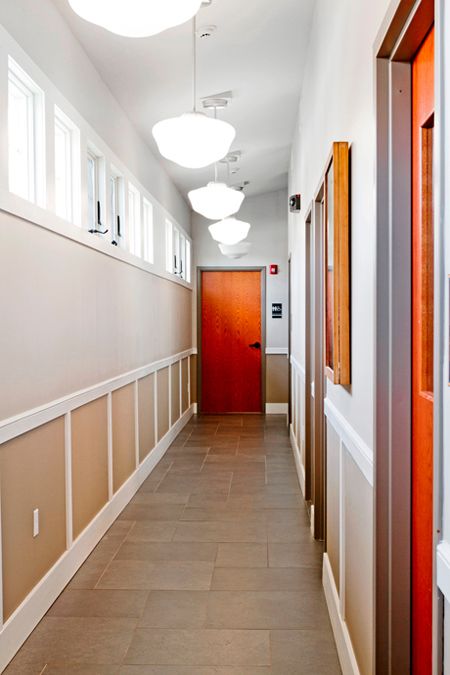
Clerestory windows line the exam room hallway at Hunterdon Hills Animal Hospital in Whitehouse Station, New Jersey, letting in lots of natural light. Photo courtesy of Rikki Snyder.
Studies show natural light improves productivity and morale for employees as compared to similar spaces that are artificially lit. In addition, if you're able to reduce the amount of artificial lighting you use as a result of adding daylight, you can also reduce utility costs.
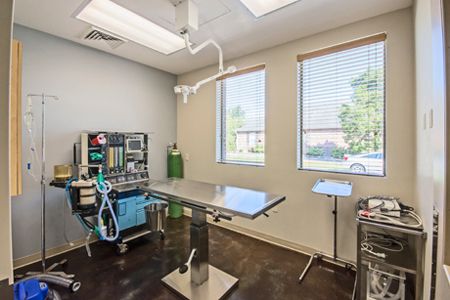
Surgery room with a view at Country Club Animal Hospital in Lake Charles, Louisiana.
> Make strategic refinishing decisions. It's easy to spend a huge amount of money and effort on refinishing projects, so be sure to prioritize the materials that really need to be replaced. In human areas only, one of the best values for a flooring change is to remove old vinyl and refinish the floor with a stained and sealed concrete surface for a contemporary look. This can be done for about $3.50 per square foot.
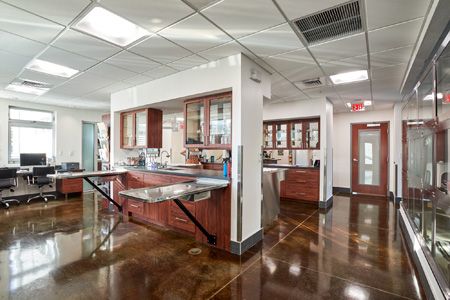
Concrete flooring at McGregor Boulevard Veterinary Clinic in Fort Meyers, Florida. Photo courtesy of Stuart Gobey, Island Studio Photography.
> Replace your destroyed cabinets. Cabinets have a short lifespan in wet and heavily used areas. If your cabinets need to be replaced, consider purchasing stainless-steel modular cabinetry. It's expensive at $150 per linear foot, but it looks beautiful, lasts forever and can be relocated, removed or sold like medical equipment. For the best value, use stainless steel for your base cabinets and plastic laminate for your upper cabinets.
3. Transform your technology
Veterinary schools use the latest methods, equipment and technology for teaching students. These students are then dismayed to graduate and find functional but seriously outdated equipment missing in their new jobs. Using up-to-date technology and equipment can be a critical issue for your practice if you want to engage new graduates. If you decide to invest in technology, be sure to advertise these new and upgraded services to your clients as well. Some options are:
> Upgrading lab, diagnostic and imaging equipment. Consider purchasing used but recently manufactured medical equipment through distributors to reduce costs.
> Going paperless. The right software can help you manage your client accounts, reduce lost billing and be more efficient. Remember: It's better to make this technological transition before you make other big changes, such as renovating the building or selling the practice.
> Improving your web presence. Your practice website and social media pages can be very effective outreach tools for your business. Take a progressive approach to implementing these tools to positively differentiate your practice from others.
Don't panic!
The average veterinary hospital can't afford the long list of renovations described above. So, take some time to focus in on what your project will be and why:
> Brainstorm a full list of improvement ideas with your partners and key staff.
> Create your own list of priorities.
> Use a design professional to help you define the scope of the possible projects more clearly.
> Seek the assistance of a builder who can give you ballpark estimates for the items on your list in an a la carte menu of options.
> Redefine your priorities again.
I know it can be hard, as the practice owner, to spend the money to tackle even a modest hospital renovation. However, a targeted remodeling project is a reasonable way to renew and refresh your own self-image and your connection to the greater community. Even better? For many practices that will struggle to find and retain good talent or prospective buyers in the coming years, a strategic remodel may be the key to building future leadership in a changing and competitive world.
Heather Lewis, AIA, NCARB, is a partner at Animal Arts, an architecture firm in Boulder, Colorado. She's a lighting geek and a (seriously) devoted advocate of minimizing pets' stress and anxiety during their veterinary visits. She has designed practices and shelters that range in size from 1,200 square feet to 110,000 square feet.